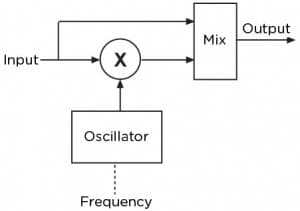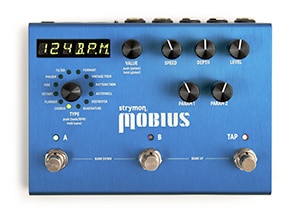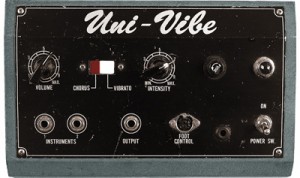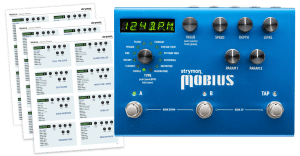
This Week’s Preset: Mobius – “Freak Minus”
For this week’s preset, I wanted to make something for electric bass. What I came up with is an envelope controlled frequency shifter. I used the Quadrature
Free US Shipping On Orders Over $49
Easy 30-Day Returns
Financing Available Through ![]()
 If you’re looking to add some ear-opening, metallic robo-strangeness to your tone, ring modulation may be just the effect you’re looking for. Since the overtones produced by a ring modulator tend to be inharmonic, the effect can be useful for sounding “out” or for playing with music that has no obvious tone center. Fun fact: Although the overtones can have a bell-like, ringing quality, the effect’s name refers to an analog circuit design featuring four electronic components (diodes) connected together in the shape of a ring.
If you’re looking to add some ear-opening, metallic robo-strangeness to your tone, ring modulation may be just the effect you’re looking for. Since the overtones produced by a ring modulator tend to be inharmonic, the effect can be useful for sounding “out” or for playing with music that has no obvious tone center. Fun fact: Although the overtones can have a bell-like, ringing quality, the effect’s name refers to an analog circuit design featuring four electronic components (diodes) connected together in the shape of a ring.
In a ring modulator, a carrier signal (usually a sine wave that’s not heard) is multiplied by an input signal (guitar, for example). The character of the effect depends on the frequency of the carrier signal. If the frequency is set very low (below the range of human hearing), instead of overtones, you will hear a tremolo effect.
 Our Mobius Modulation pedal includes a classic ring modulator effect. To access it, select the Quadrature mod machine type, set the Mode to AM (amplitude modulation), and turn the Mix parameter up at least halfway. The Shift parameter controls the frequency of the carrier signal. For an expressive effect, try using a fairly high Shift value, set the expression pedal to control Mix, and blend in a bit of ring modulation when you want to accent your sound. The Speed and Depth controls can be used to add more movement to the sound. Another cool effect is to set the mix 100% wet and control the carrier frequency (Shift parameter) with your expression pedal. Start playing a pattern at a relatively high Shift value, then ease back the expression pedal until the sonic chaos resolves into a lovely tremolo effect.
Our Mobius Modulation pedal includes a classic ring modulator effect. To access it, select the Quadrature mod machine type, set the Mode to AM (amplitude modulation), and turn the Mix parameter up at least halfway. The Shift parameter controls the frequency of the carrier signal. For an expressive effect, try using a fairly high Shift value, set the expression pedal to control Mix, and blend in a bit of ring modulation when you want to accent your sound. The Speed and Depth controls can be used to add more movement to the sound. Another cool effect is to set the mix 100% wet and control the carrier frequency (Shift parameter) with your expression pedal. Start playing a pattern at a relatively high Shift value, then ease back the expression pedal until the sonic chaos resolves into a lovely tremolo effect.
Check out some of the unique sounds that can be created with the Mobius Quadrature effect below.
To learn more about Mobius, take a look here. 🙂
Subscribe to our newsletter to be the first to hear about new Strymon products, artist features, and behind the scenes content!

For this week’s preset, I wanted to make something for electric bass. What I came up with is an envelope controlled frequency shifter. I used the Quadrature

What was the original Uni-Vibe exactly? A vibrato pedal? Leslie simulator? Chorus? Phaser? Well, yes and no, sort of? To hear a beautiful example of

Hi Mobius users—many of you have asked us to put together a detailed list of the Mobius factory preset settings. Here is a PDF
2 Responses
EXCELLENT!
Interesting article on the ring modulator effect! It’s great to learn about this technique and its applications in music production. Thanks for sharing!